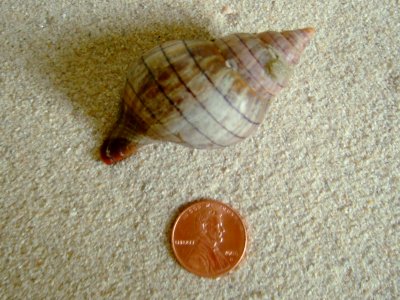
Banded Tulip Shell
Fasciolaria lillium G. Fischer, 1807

Banded Tulip Shell
Fasciolaria lillium G. Fischer, 1807
The Banded Tulip Shell is a spindle-shaped univalve with a long siphonal canal. It has an elevated spire and distinct sutures. The shell may reach a height of over four inches. The typical background color of the shell is ivory or blueish gray with mauve streaks, cloudings of white or gray, and revolving lines of rich, dark reddish brown, although among the five distinct subspecies there are variations in shell markings and coloration.
There is also a similar “true” Tulip Shell, Fasciolaria tulipa Linne. The typical Banded Tulip Shell has seven thin distinct brown lines on its main body whorl, and the sutures between the whorls are smooth. The True Tulip Shell has 15 or more faint brown lines on its main body whorl, and its sutures are rough. The Banded Tulip, as mentioned, is seldom much over four inches tall. The True Tulip can reach ten inches in height.
Tulip Shells are home to black snails. This snail, when threatened, can retreat into its “house” and close the “door,” or operculum, which is a lid-like horny plate on the gastropod's foot. The Tulip Shell's operculum is oval in shape and chestnut-colored with an apical nucleus.
Tulips are slow, aggressive carnivores, preying on other large gastropods, such as Pink Queen Conchs (and even other Tulip Shells) and bivalves, such as clams.
Using its radula, a “toothed” tongue, the Tulip bores a hole through the shell of its victim, and then inserts the tongue to devour the soft contents.
The Tulip Shell gastropod's head has two tentacles with an eye at the base of each. The female Tulips deposit parchment-like, flattened, vase-shaped oviger (egg) capsules in clumps. These clumps of eggs are attached to rocks or other hard surfaces. Most of the eggs are unfertilized or are arrested in development. These “dud” eggs are eaten by the normal, developing snails while they are still in the egg capsule. After about a month the tiny Tulips emerge from the eggs.
The Banded Tulips live in sandy-detrital or muddy bottoms in the infra-littoral zone, in water 2-150 feet deep. Their habitat is off the coast of North Carolina as far south (and west) as Alabama and perhaps over to Texas.
The Banded Tulip is edible. The flavor is much like conch or whelk meat.